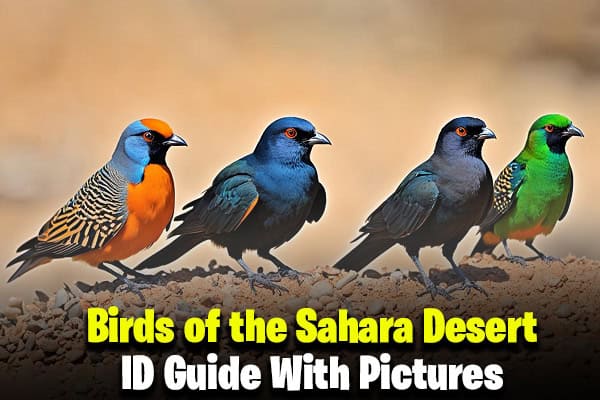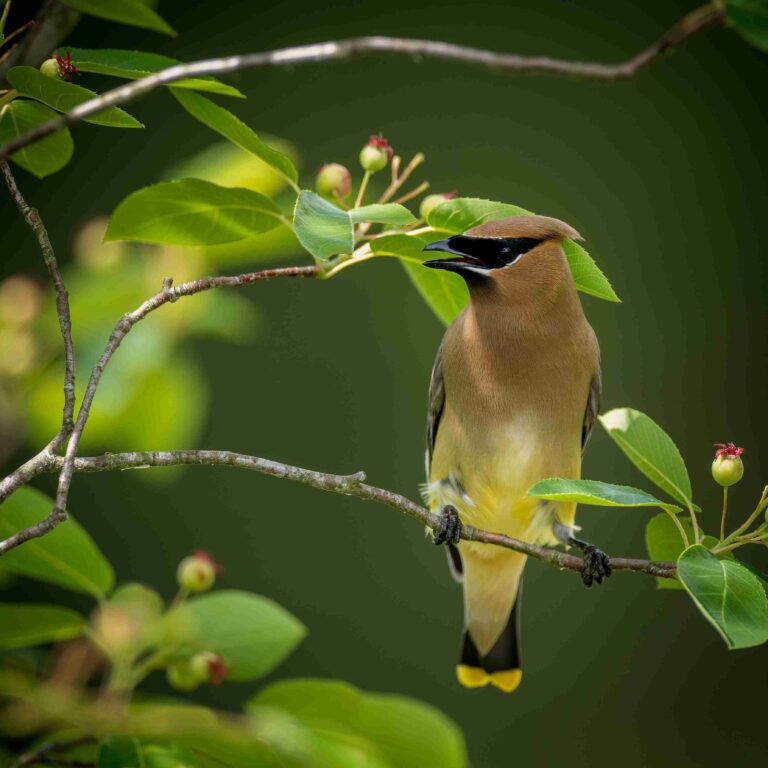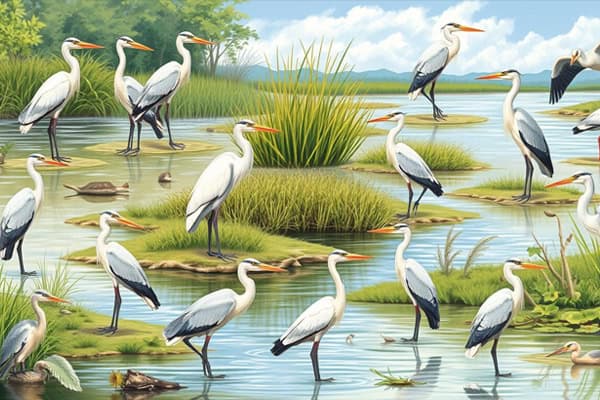Top 7 Birds of the Sahara Desert (ID Guide With Pictures)
Ever wondered about the birds that live in one of the driest places on Earth? The Sahara Desert is full of amazing birds, each one special for surviving in the harsh conditions. This guide will show you the top birds of the Sahara that fly through the sky and are vital to their ecosystem. From the tall Common Ostrich to the hidden Pharaoh Eagle-Owl, these birds show how wildlife thrives in the Sahara. Are you ready to learn more about the birds of the Sahara and improve your birdwatching skills?
Why the Sahara is Unique for Birdwatching?
Birdwatching in the Sahara lets you see species that live in many places. This huge desert has many unique birds, found nowhere else. The mix of vast sands, high mountains, and small oases makes a special place for birds.
The Sahara has many different places, each home to different birds. You might see the rare Desert Sparrow or the big Pharaoh eagle owl hunting at night. Each place has its own way of supporting birds, making birdwatching here very rewarding.
Exploring the Sahara, pay attention to the different places birds live. From green palm groves to dry rock formations, each spot is full of surprises. With patience and careful watching, you can see these special birds in their natural world.
Your trip to the Sahara will be full of exciting bird encounters. Every part of this big area has something special to offer. It’s a great place for bird lovers who want to learn more about nature.
1. Common Ostrich: The Largest Bird of the Sahara
The Common Ostrich is a key part of the Sahara Desert. It’s the biggest bird around, known for its size and special features. Learning about ostrich behavior and traits helps us appreciate these amazing birds more.
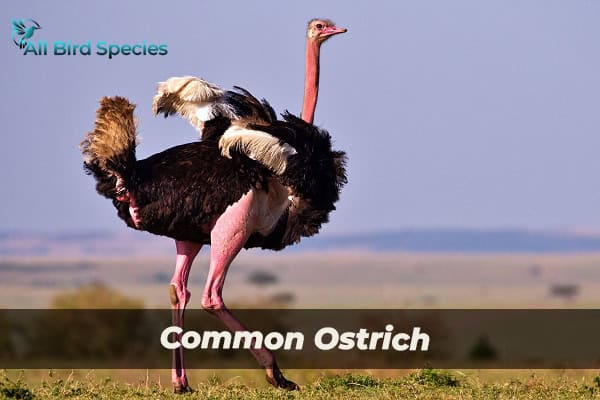
Physical Characteristics and Behavior
The Common Ostrich has unique features. It can reach up to 2.7 meters tall and weigh as much as 145 kg. Its long, strong legs let it run over 70 km/h. Even though it can’t fly, it moves fast and lives in groups for safety.
During non-breeding seasons, up to 50 ostriches gather together. They’re not just friends; they help protect each other from predators.
Habitat and Range in the Sahara
Ostriches live in different places, mainly in the Sahara. They love grasslands and savannahs, near water because they need it to survive in the desert. The Sahara has many places perfect for them, like areas with acacia trees and open grass.
They can be found in North Africa, the eastern parts, and Southern Africa. Their ability to adapt to tough climates shows how resilient they are.
2. Lappet-Faced Vulture
The Lappet-Faced Vulture, also known as the Sahara vulture, is a fascinating bird of the desert. It’s big and has unique features that make it easy to spot for bird lovers.

Identification Features and Size
This bird has a huge wingspan of almost 2.8 meters. It’s easy to tell apart because of its bare head, which can be pink or brown. The skin folds on its neck, called lappets, are another key feature.
Adults have dark brown feathers that stand out against their light heads. These traits help birdwatchers identify them and are crucial for their survival.
Role in the Desert Ecosystem
The Lappet-Faced Vulture is key to the Sahara’s ecosystem as a scavenger. They eat carrion, which helps break down dead animals and keeps the environment healthy. Their sharp eyes can spot food from far away, which is vital for them.
They build big nests with sticks in trees or on cliffs. This helps them thrive as Sahelian vultures.
3. Pharaoh Eagle-Owl
The Pharaoh Eagle-Owl is a fascinating bird of the desert nightlife. Known as Bubo ascalaphus, it’s known for its large size, with wings up to 1.5 meters wide. Its bright yellow eyes and big ear tufts make it stand out in the Sahara’s dark landscape.
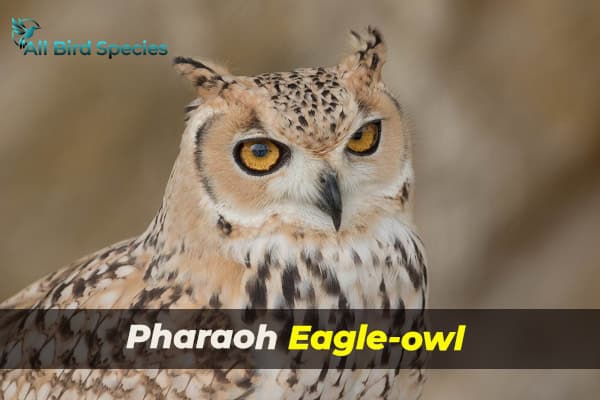
Distinctive Appearance and Hunting Tactics
What makes the Sahara owl a top hunter in the desert? Its owl-hunting skills are unmatched. It has sharp hearing and great eyesight, hunting small mammals, birds, and reptiles at night. The Pharaoh Eagle-Owl is silent while hunting, surprising its prey with stealth.
It uses camouflage to hide in the desert. Its feathers match the desert’s colors and textures, helping it move quickly and strike without being seen.
| Characteristic | Detail |
|---|---|
| Wingspan | Up to 1.5 meters |
| Eye Color | Striking yellow |
| Hunting Time | Nocturnal |
| Main Prey | Small mammals, birds, reptiles |
| Hunting Technique | Silent approach, camouflage |
In the Sahara, the Pharaoh Eagle-Owl is the desert night’s master. It’s a mix of stealth and beauty. Its features and hunting skills show its important role in the desert’s ecosystem.
4. Desert Lark
The Desert Lark, known as Ammomanes desert, shows amazing bird adaptations for living in harsh places. This small bird is a key example of the Sahara lark species. It has traits that help it survive in dry lands.
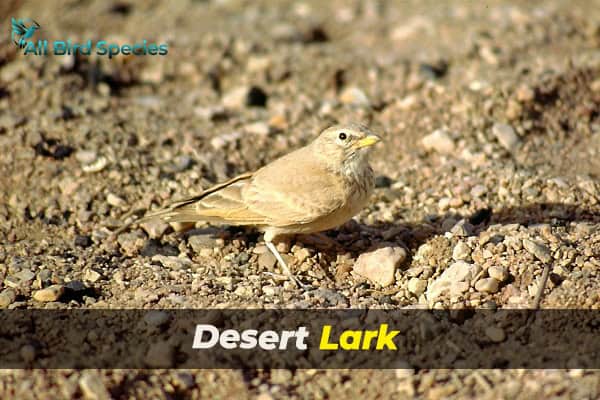
Adaptations for Survival in Arid Conditions
Its light-colored feathers help it stay cool by reflecting the sun’s heat. This camouflage keeps it safe from predators. The lark’s feet are made for walking in sand, showing how well it’s adapted to its environment. They also get moisture from plants and dew, solving the problem of little water.
Behavior and Nesting Practices
Desert Larks are interesting to watch as they search for food alone or with a few friends. They eat insects and seeds, finding them across their wide territory. Desert Lark nesting is unique, happening in sandy soil or under bushes. These spots keep their babies safe from predators. They breed during the rainy season, making sure there’s enough food for their young.
5. Crowned Sandgrouse
The Crowned Sandgrouse is a fascinating bird of the Sahara, known for its unique look and habits. They blend into the desert with their earthy colors. Males show off a special crown of feathers during mating.
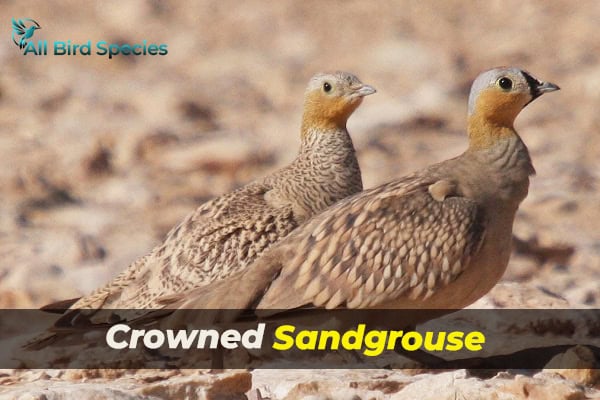
Identification and Unique Traits
Spotting the Crowned Sandgrouse is easy once you know what to look for. Males and females have different looks, making them easy to tell apart. Males have a bright crown and detailed feathers, while females blend in better with their surroundings.
Feeding and Watering Habits
These birds of the Sahara have special ways of surviving in the desert. They eat seeds with their unique bills. Finding water is tough for them, so they travel far to get it. When they do find water, they soak their feathers to keep their chicks hydrated later.
| Characteristic | Males | Females |
|---|---|---|
| Plumage Coloration | Vibrant browns and whites with a crown | More subdued earthy tones |
| Size | Medium, around 30-32 cm | Similar size |
| Feeding Behavior | Seeds, foraging on the ground | Same as males |
| Watering Behavior | Soaks feathers for chicks | Same as males |
6. Desert Sparrow
The Desert Sparrow, known as Passer simplex, is a bird that has adapted well to the Sahara’s tough landscapes. It shows amazing bird characteristics that help it survive in tough places.
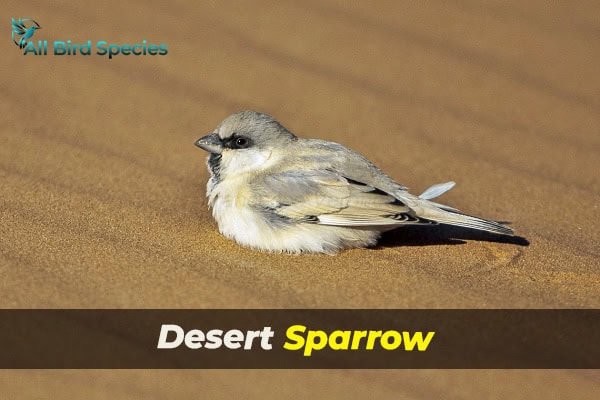
Physical Characteristics
This bird is about 12 to 13 cm long and has a sturdy body. Its feathers are sandy brown, helping it blend in with its desert home. The short tail and subtle colors also help it hide from predators. This Sahara sparrow has features like:
- Compact body structure
- Short, rounded wings
- Subtle variations in plumage color
Habitat Preferences
The Desert Sparrow habitat is mostly in areas with little vegetation. They live near oases or human places, showing they can adapt. Their usual sparrow living conditions are:
- Nesting in crevices or grass tufts for protection
- Thriving in areas with limited vegetation
- Seeking out areas where water is accessible
Learning about the bird habitats Sahara helps us see how this desert bird thrives.
| Feature | Description |
|---|---|
| Body Length | 12-13 cm |
| Coloration | Sandy brown and lighter tones |
| Nesting Sites | Crevices, grass tufts |
| Preferred Areas | Oases, human settlements |
7. Brown-Necked Raven
The Brown-Necked Raven lives in the tough Sahara Desert. It stands out with its brown neck against dark feathers. This bird is smart and can handle the desert’s tough conditions.
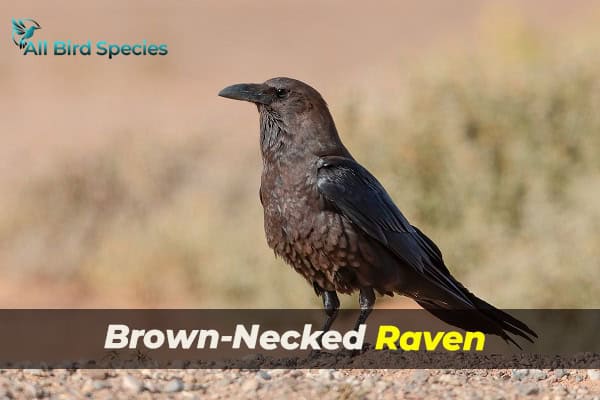
Behavioral Traits and Diet
This raven shows off its smart ways, making it a top bird in the area. They live in groups, which helps them find food and stay safe. They eat a wide variety of things, including:
- Insects
- Seeds
- Carrion
Brown-Necked Ravens are smart foragers. They use tools to get food and protect their space. This shows how smart and flexible they are, important for living in a tough place.
| Trait | Description |
|---|---|
| Diet | Insects, seeds, carrion |
| Social Structure | Forms flocks for foraging and protection |
| Intelligence | Uses tools; exhibits problem-solving behavior |
Watching the Brown-Necked Raven shows us how amazing these desert ravens are. Their smartness and resourcefulness are truly fascinating.
Birdwatching Tips for the Sahara
Going on a birdwatching trip to the Sahara needs careful planning and knowing the best times and places. With the right birdwatching tips, you can make your trip better and see more bird species.
Best Times and Locations for Birdwatching
The Sahara is great for birdwatching in spring and autumn. These seasons are when many migratory birds pass through. To see the most birds, check out these top spots:
- Oases, where birds gather for water and food
- Wetlands, providing essential habitats for various species
- Areas with sparse vegetation, perfect for observing ground-feeding birds
Early mornings and late afternoons are best for birdwatching. Birds are usually out foraging and socializing during these cooler times.
Essential Gear and Preparation
To be ready for birdwatching in the Sahara, you need the right gear. The right equipment makes sure you’re comfortable and ready for anything. Here’s what you should bring:
- Binoculars for clear, close-up views of distant birds
- A field guide to help identify species
- Sunscreen to protect your skin from the harsh sun
- Ample water to avoid dehydration in the heat
- Record-keeping materials, like a notebook or phone app, to document your sightings
Wear light, breathable clothes to stay cool and comfortable. This way, you can enjoy the beautiful birds of the Sahara without getting too hot.
Conservation Status of Birds in the Sahara
The situation for Sahara bird species is getting worse. Many birds face threats like habitat loss, climate change, and human activities. These threats put essential ecosystems at risk.
It’s crucial to save Sahara birds. Species like the Lappet-Faced Vulture and Pharaoh Eagle-Owl are endangered. We need to act fast to protect them. You can help by spreading the word and pushing for better laws.
Effective conservation strategies include:
- Identifying and protecting critical habitats
- Implementing sustainable land-use practices
- Educating local communities about the importance of preserving Sahara bird species
Research is key to understanding why these birds are disappearing. Conservationists use studies to make informed decisions and take action. By supporting birdwatching groups and wildlife protection, you can make a big difference.
| Bird Species | Status | Primary Threats |
|---|---|---|
| Lappet-Faced Vulture | Endangered | Habitat destruction, poisoning |
| Pharaoh Eagle-Owl | Vulnerable | Human encroachment, climate change |
| Desert Sparrow | Least Concern | Habitat alteration |
We all need to work together to save Sahara birds. Every effort counts in protecting the diverse bird life of this unique place.
Frequently Asked Questions About Sahara Birds
Q1: What kind of birds are in the Sahara?
The Sahara hosts various birds including the lanner falcon, Egyptian vulture, and sandgrouse.
Q2: What is the largest bird in the desert?
The largest bird in the desert is the ostrich.
Q3: What is the most common animal in the Sahara?
The most common animal in the Sahara is the dromedary camel.
Q4: Do flamingos live in the Sahara Desert?
Yes, flamingos can be found in the Sahara, particularly around seasonal lakes and salt flats.
Final Thoughts
As we finish this Sahara birdwatching summary, it’s clear the Sahara Desert is home to many unique birds. From the impressive Common Ostrich to the hidden Pharaoh eagle owl, each bird plays a big role in the ecosystem. Seeing these amazing birds in the wild makes birdwatching even more special.

